Turbines
Advanced Micro Turbines (A.M.T.) of The Netherlands
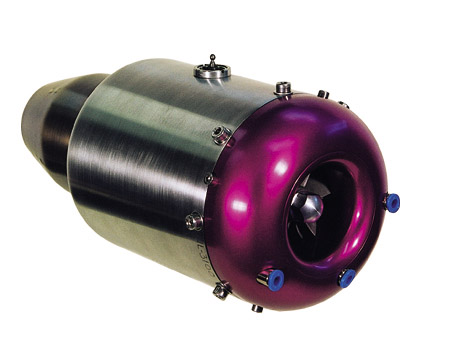
AMT Mercury (above) and Pegasus (below) turbine engines from http://www.amtjets.com/
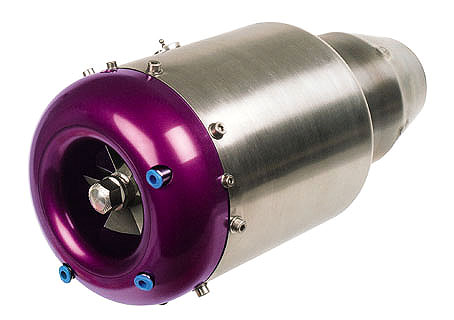
| Mercury | Pegasus | Olympus | |
|---|---|---|---|
| Engine diameter | 100 mm | 120 mm | 130 mm |
| Engine length (Air start engine) | 220 mm | 264 mm | 267 mm |
| Engine length (Electric start engine) | 292 mm | 342 mm | 374 mm |
| Engine weight (Air start engine) | 1400 g | 2125 g | 2475 g |
| Engine weight (Electric start engine) | 1550 g | 2255 g | 2850 g |
| System airborne weight (Air start system). Engine, ECU, pump, battery, thermosensor, straps | 2005 g | 2705 g | 3150 g |
| System airborne weight (Electric start system). Engine, ECU, pump, battery, thermosensor, straps. | 2235 g | 3075 g | 3795 g |
| Thrust @ S.T.P. * (see below). 15 Deg. Celsius / 1013 Mbar. 59 Deg. Fahrenheit / 29,91 in. | 88N / 9Kg @ 151,200 | 167N / 17.0KG @119,500 ** | 230N / 23.5KG @108,500 |
| Maximum allowed r.p.m. | 151,900 | 120,000 | 112,000 |
| Thrust @ idle r.p.m. | 4 N | 6 N | 8 N |
| Idle r.p.m. | 47,600 | 37,000 | 36,000 |
| Pressure ratio @ max. r.p.m. | 2.8 : 1 | 3.2 : 1 | 3.8 : 1 |
| Mass flow. | 250 g/sec @88 N | 375 g/sec @157 N | 450 g/sec @230 N |
| Normal Exhaust GasTemperature | 650 C | 600 C | 700 C |
| Maximum Exhaust GasTemperature | 750 C | 675 C | 750 C |
| Fuel Consumption @ max. r.p.m. and S.T.P. * (see below) | 290 g/min @88 N | 450 g/min @157 N | 640 g/min @230 N |
Notes
S.T.P. Standard Temp. & Pressure:
- Temp: 15 Degrees Celcius / 59 Degrees Fahrenheit
- Pressure: 1013 Mbar / 29.91 in
Suitable oils are
- AeroShell 500 (delivered with AMT Netherlands engines)
- AeroShell 560
- Mobil Jet oil II
Table and notes from http://www.amtjets.com/
Graupner JetCat series

The Graupner JetCat P80 turbine, from http://www.jetcatusa.com/p80.html
JetCat P-80 turbine complete with starter includes:
- Jet-tronic ECU (fuel control electronics)
- GSU (Display and Programmer)
- LED I/O board
- Miniature fuel pump
- Electronic starting gas valve
- Electronic Fuel valve
- Fuel tubing, tubing connector set, filters, and cable set
- 6 cell, 1250mA battery pack
- Starting gas tank
- Turbine mounting clamp, RamTec compatible
- Detailed instruction manual
| Thrust | 93.5 N @ 123,000 RPM |
| Weight | 1.318 kg, incl. starter |
| Diameter | 112 mm |
| RPM Range | 35,000 - 120,000 |
| Exhaust gas temp | 580°C -690°C |
| Fuel consumption | 256 g per/min at full power |
| Fuel | Jet A1, 1-K kerosene |
| Lubrication | approximately 5% synthetic turbine oil in the fuel |
| Maintenance interval | 25 hours |
P80 thrust chart
The values are approximate and can vary slightly from engine to engine. Values at Standard Temperature and Pressure.
| P60 | P70 | P80 | P120 | TITAN | P180 | |
| thrust: N @ rpm | 57.9 @ 165,000 | 77.9 @ 123,000 | 93.5 @ 123,000 | 124.7 @ 123,000 | 151.4 @ 123,000 | 200.4 @ 110,000 |
| Fuel use in g / min | 227g | 227g | 256g | 341g | 454g | 682g |
| weight in kg | 0.841 | 1.182 | 1.318 | 1.409 | 1.409 | 2.273 |
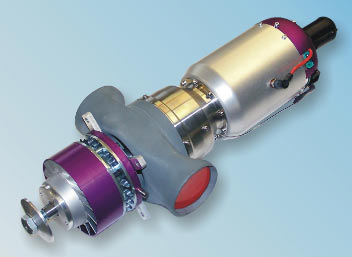
JetCat SPT5 turboprop using a P60 turbine from http://www.jetcatusa.com/spt5.html
| Thrust | 245 N with 27" prop at 7,000 RPM |
| Weight | 2.227 kg, incl. starter |
| Length | 387 mm |
| Diameter | 50,000 - 165,000 |
| RPM Range | 1,500 - 7,000 RPM |
| Exhaust gas temp | 580°C -780°C |
| Fuel consumption | 227 g per/min at full power |
| Fuel | Jet A1, 1-K kerosene |
| Lubrication | approximately 5% synthetic turbine oil in the fuel |
| Maintenance interval | 25 hours |
Notice the greater thrust for a given fuel consumption for the turbprop engine relative to the turbine engine alone. Data taken from http://www.jetcatusa.com/spt5.html site.
Product information from https://shop.graupner.de/webuerp/servlet/AI?ARTN=6797
Turbine technology offers many advantages, but model aircraft with conventional propeller power systems have never been able to exploit them. Now they can: the Graupner/JetCat SPT5 turbo-prop engine represents a successful combination of high power reserves and High-Tech engineering. In the world of full-size aviation most types of propeller-driven machine have already been converted to turbo-prop power, but the engine´s relentless progress has only just begun in the model arena. As the name indicates, the turbo-prop engine - its full name is a turbo-jet propeller engine - comprises a gas turbine driving an airscrew.
The secondary shaft directly drives a gearbox designed to cope with high rotational speeds, and this in turn reduces the speed to a value suitable for a propeller. The gearbox is fitted with anintegral axial fan which provides the necessary airflow for cooling the components subject to high temperature. Another completely new feature of the engine is the electronic control system, which processes the speed information derived from both shafts: primary and secondary. This simply means that the pilot can concentrate entirely on flying, while the complex engine management processes are carried out fully electronically. The reduction gearbox is a specially developed planetary design, highly efficient and very compact.
When ever a new kind of power system concept is introduced, the model flyer is obliged to immerse himself in the subject in order to gain the necessary expertise, and this certainly applies to turbines. However, once the operator has become familiar with the procedure, it is actually simpler to handle a turbine installed in a model aircraft than to operate a piston engine: only a single radio control system channel is required to control the engine, and starting preparations for the engine simply boil down to filling the fueltank and a small auxiliary gas tank required to start the turbine.
The engine starts at the press of a button from the transmitter, where upon the entire starting process runs automatically, controlled by the turbine's on-board electronics (ECU). Initially the integral electric motor accelerates the turbine to a speed of around 6000 rpm, then the auxiliary gas supply is opened and the gas is ignited in the turbine's combustor. The turbine then continues to accelerate until the burning gas overtakes the starter motor's speed the motor then disengages, and the turbine continues to accelerate until it reaches a speed high enough to support running on kerosene.
Once the start-up process is completed successfully, the ECU sets a stable idle speed before transferring control to the pilot. After the flight the pilot reduces engine speed in the usual way, then - using the same channel - he initiates the power-down process, which is again entirely automatic, under the control of the on-board electronics: first combustion is halted, then the starter motor is switched on again to push fresh air through the turbine until the internal temperature has fallen to below 100°C. An LED in the model lights up to indicate that this cooling-off phase is complete, at which point the receiving system can safely be switched off.
Wren turbines
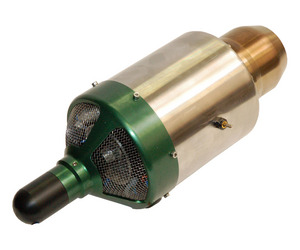
Wren SuperSport turbine, from wrenturbines.co.uk
| MW 44 | MW 54 | SuperSport | XL 200 | |
|---|---|---|---|---|
| thrust in N | 45 | 64 | 81 | 147 |
| Fuel usage in ml / min | 176 | 230 | 290 | 494 |
| weight in grams | 600 | 990 | 960 | 1,800 |
Wren helicopter engine - £2,700
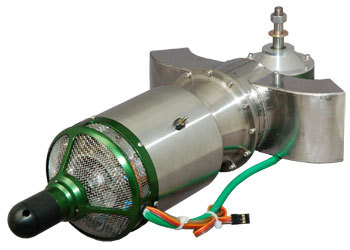
Photograph and data from http://wrenturbines.co.uk
| Power | 6 kW @ 14,500 gearbox rpm |
|---|---|
| Diameter | 90 mm core engine |
| Length | 360 mm |
| Engine weight | 2.077 kg |
| Ancillaries weight | 350g |
| Gearbox RPM range | 4,300 - 14,500 rpm |
The complete system package contains:
- Helicopter Engine
- Autostart ECU
- Hand Data Terminal
- Solenoid valves
- Pump
- Engine mount
- Gas and fuel pipes
- Gas bottle valve
- Gas connector
- Onboard gas tank
- Operator's manual
Wren turboprop
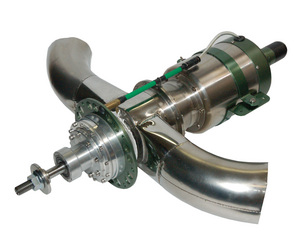
| output power | 6 kWatts at 7,000 rpm |
|---|---|
| weight | 2.3 kg |
| propeller speed | 1,100 to 7,000 rpm |
The turbine powered helicopter
The turbine powered helicopter has several advantages:
- electric start
- low vibration level
- high engine power (typically 6 kWatts)
and several problems:
- very high fuel consumption
- noisy
- relatively expensive
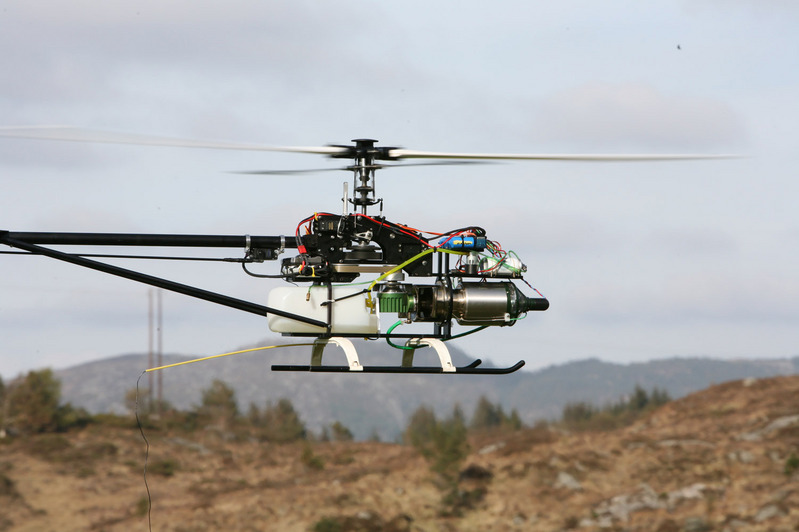
The Robbe Nova Cuatro owned by Birger Hovland. Photograph from http://wrenturbines.co.uk
EADS Turbine powered target Unmanned Aircraft

Above and below photographed at the EADS stand at the Dubai 2007 Air Show.
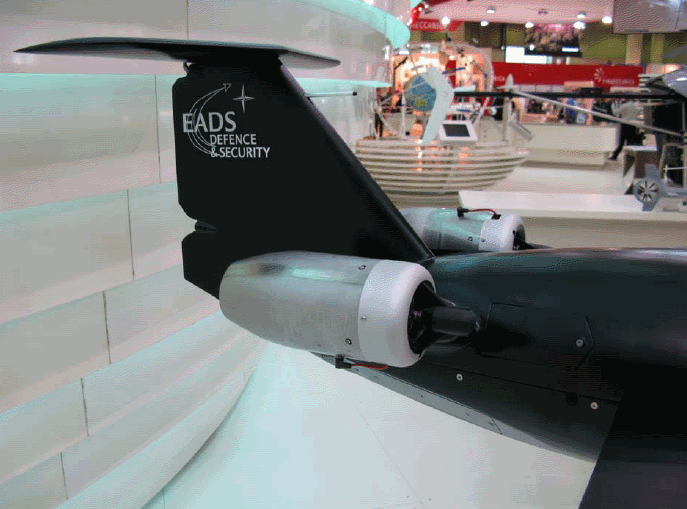
ONERA develops micro-UAV gas turbine engine
French aerospace agency ONERA has tested a tiny combustion chamber for use in a prototype micro gas turbine that could be built by 2010 for use in a miniature Unmanned Aircraft.
By Rob Coppinger, DATE: 8 February 2008, SOURCE: Flight International.
Tested at ONERA's Laerte laboratory in Palaiseau, near Paris, the combustion chamber has a volume smaller than 10mm^3 and is intended for a micro-turbine that is 20mm in diameter by 20mm high. This will power a micro-UAV with up to a 20 cm wingspan, says ONERA.
Air and fuel, either hydrogen or propane, are injected separately into the micro-turbine, which produces mechanical energy that is then converted into electricity. "The power required is between 50 and 100W [for] an expected UAV endurance of 30min," says ONERA.
The agency has concluded that fuel cells of sufficent power density will not exist for some time and that batteries will always be too heavy.
Hydrogen is used as a fuel because its chemical reaction occurs in 50µs, a tenth of the time for normal hydrocarbons, ensuring that ignition occurs before the gas exits the tiny combustion chamber. Another major challenge is the thermal losses caused by the chamber's relatively large surface area, which can extinquish combustion.
The next step is to study the rotation of a centripetal silicium turbine wheel 8 mm in diameter with paddles 400 µm in height. These would be manufactured using either silicon etching or micro-machining. The work will investigate the ability of the micro-turbine to attain rotation speeds of several hundred thousand revolutions per minute. The target speed is 1 million rpm. With such high rotation speeds, tiny hydrodynamic bearings will be used so their gases can keep the rotating surfaces from catastrophically touching.